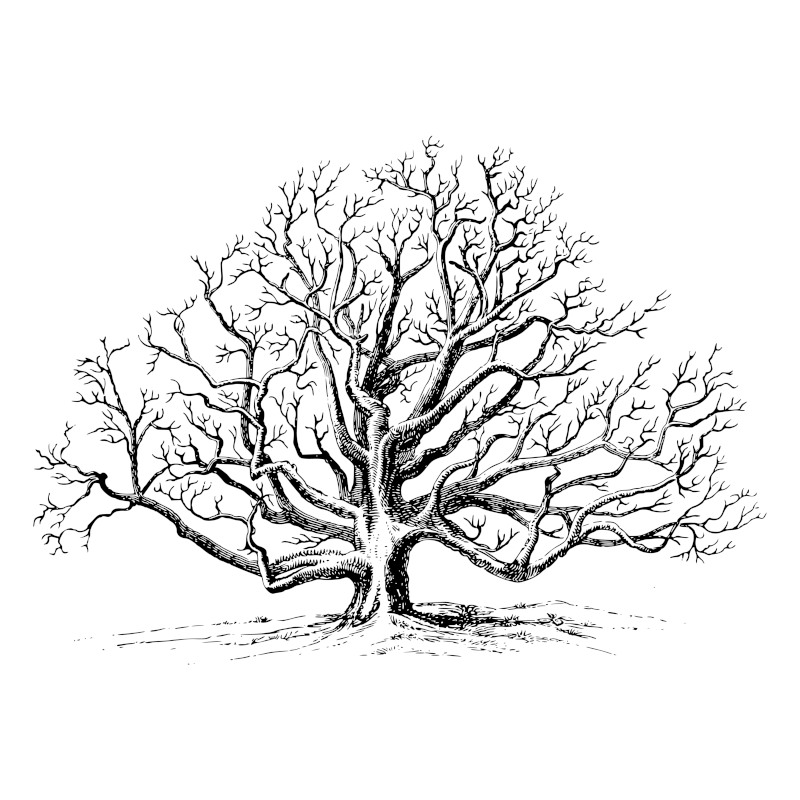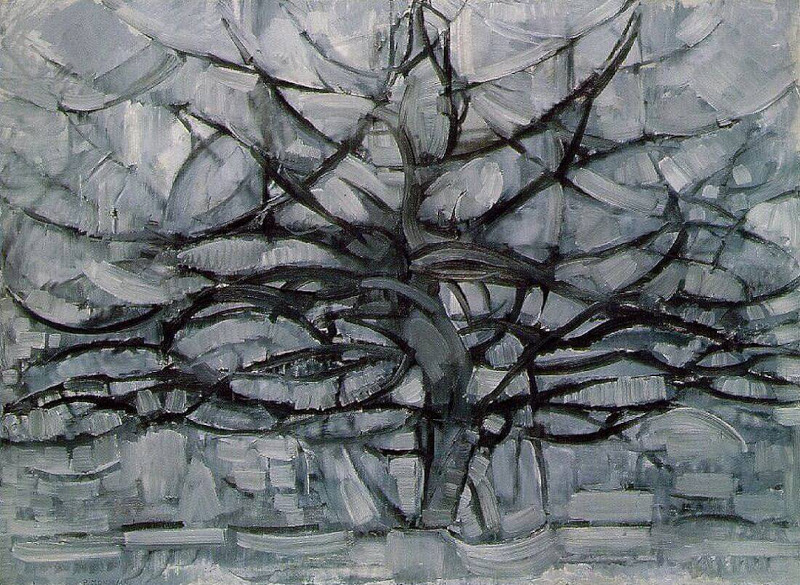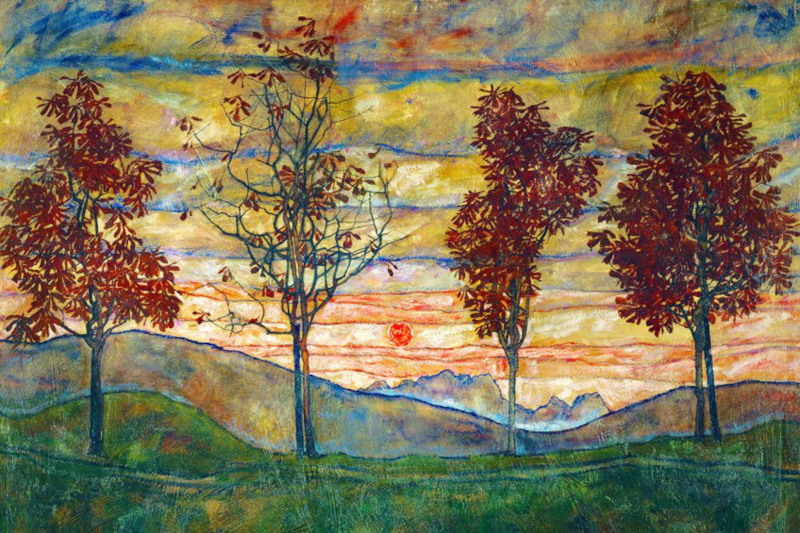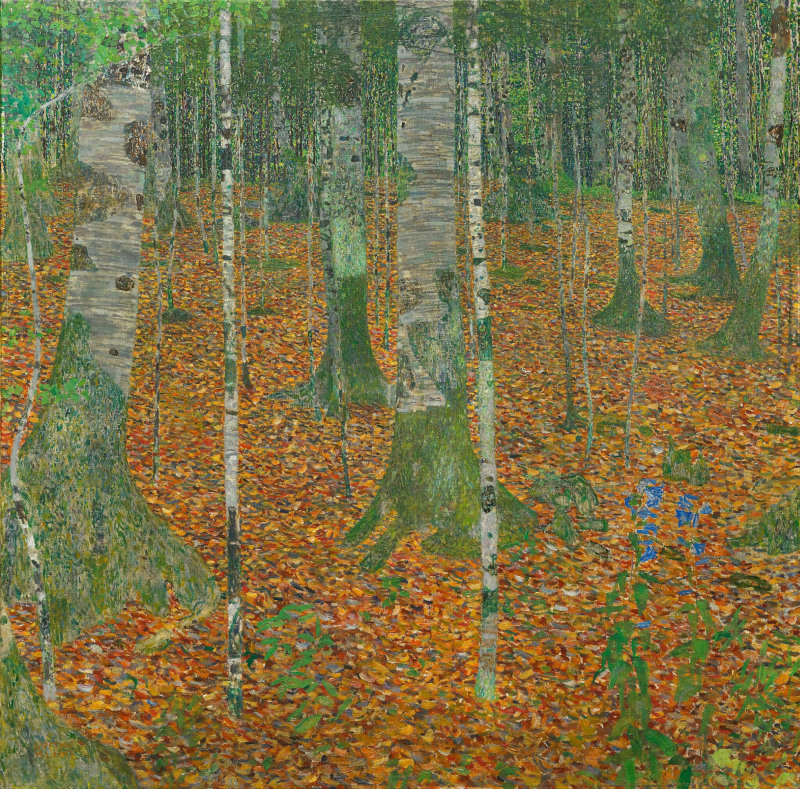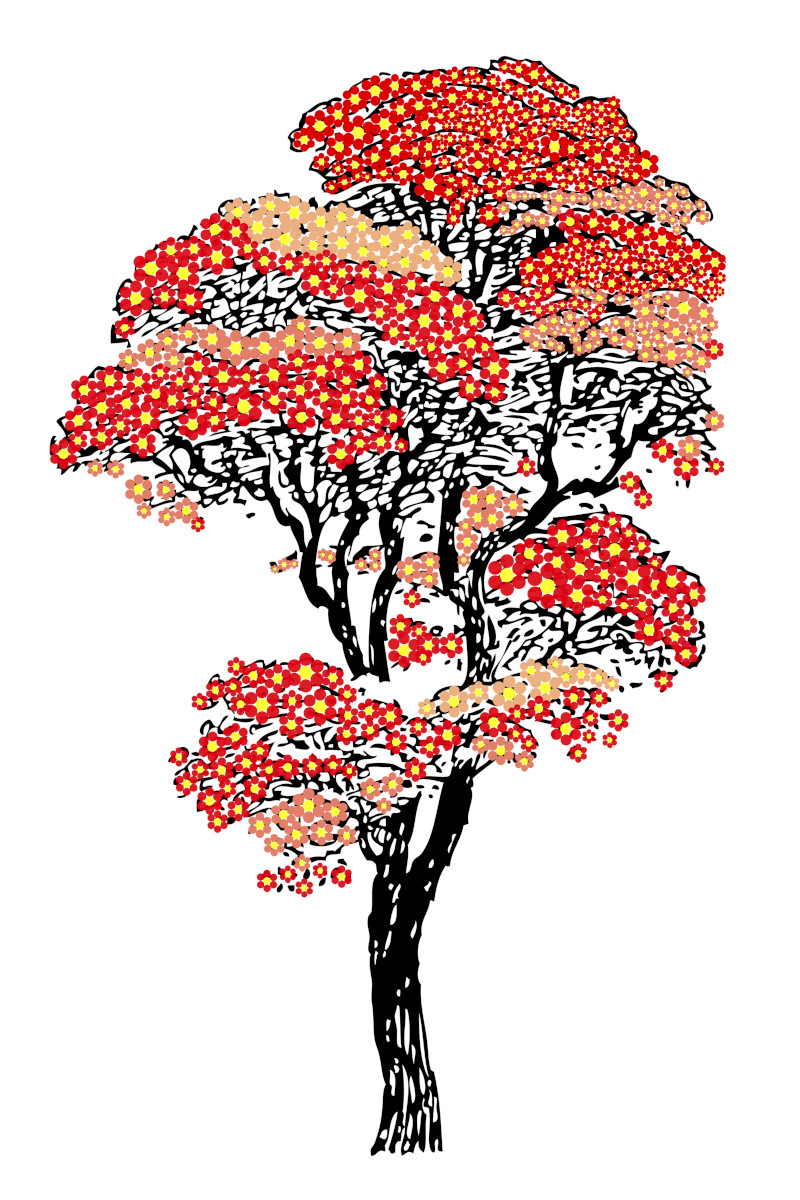Discover a selection of tree drawings and paintings in this extensive article which also offers some easy tree drawing techniques and tips for those new to art.
Introduction to Tree Drawings
The depiction of trees within art has been around since ancient times. Many civilizations found them to contain religious and spirital values, whilst today we prefer to enjoy their aesthetic values. Trees have such an important role in society that their inclusion in art should not come as a surprise, and today huge efforts are made to protect them, as well as encouraging more to be planted in order to protect the environment.
Indeed, many artistic tools that we use rely on trees, whilst a number of artistic techniques also exist that make use directly of their attributes, such as tree rubbing. Below our list of tree artworks, you will also find further discussion on a number of related topics, such as the way in which to analyse the anatomy of a tree, and also the different attributes found with the many types of trees.
List of Tree Drawings and Paintings
We have put together a wide range of different styles below in our list of tree art, with some artworks being from famous artists, and also a good range of nations included, such as western nations and also Japan. This list should summarise the variety of work that has come about over the past centuries, from abstract ideas all the way through to highly precise sketches for scientific purposes.
The hope is that some of these ideas will inspire you to produce tree art of your own, perhaps by tracing the outlines of some of these drawings, or just giving you the inspiration to go outside and making your own work. Photographs can also be a good idea for those who prefer the comfort of working indoors, or alternatively you might make quick, easy sketches whilst observing trees, and then extend these into more complex artworks once in your own studio.
Walnut Tree Vintage Illustration
This crisp drawing of a walnut tree balances light and dark to add depth to the piece. Lines are delivered at different angles to slowly create texture across the branches. The branches also slowly become thinner and thinner as they move away from the central trunk. This precise piece would likely have arrived after many years of practice, finetuning the drawing techniques found in this artwork.
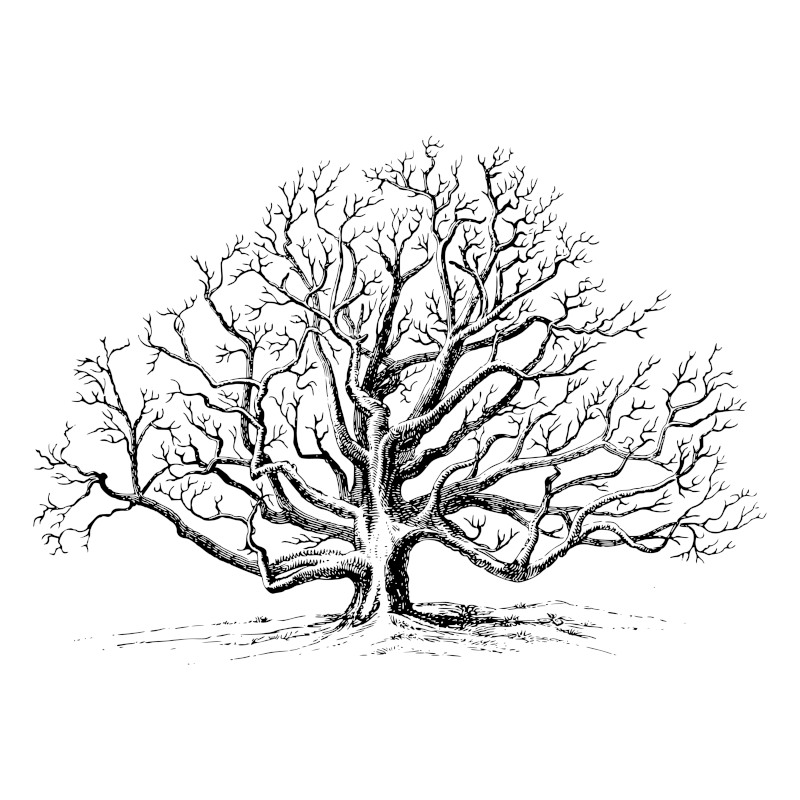 Walnut Tree Vintage Illustration
Walnut Tree Vintage Illustration
The Tree of Life by Gustav Klimt
The Tree of Life was a popular theme with a number of religions, with its image representing the cycle of life itself, as well as serving as a centre of knowledge. Klimt's Tree of Life was a part of a larger mural but became the best known section of it. Klimt swirls the branches in a dream-like manner, and fills them with stunning touches of gold leaf paint which provided a stunning work which was typical of the Art Nouveau era.
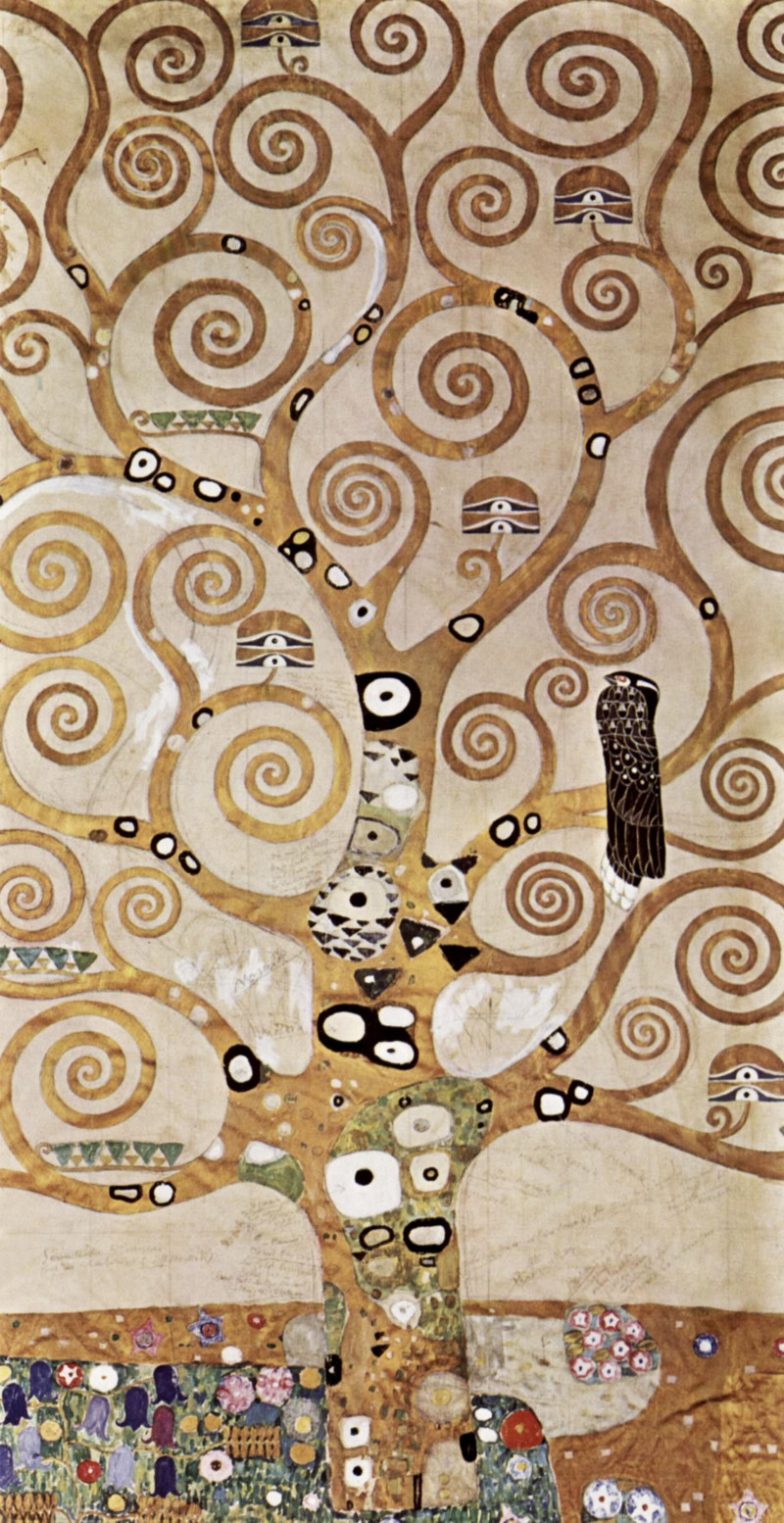 The Tree of Life by Gustav Klimt
The Tree of Life by Gustav Klimt
Gray Tree Piet Mondrian
Mondrian produced a number of tree paintings during the early part of his career, just as he was starting to transition towards abstraction. In this example he works in an expressive manner, fragmenting up the tree into a series of fractals, and also uses a dark mood using a limited palette. He would continue in this style but with brighter tones in other examples.
Four Trees by Egon Schiele
Amongst the most popular tree painting of all is Schiele's Four Trees. The way in which the trees are perfectly in line is clearly amended from reality, but the colours and sky are breathtaking. Single lines cut across the horizontal, with alternative tones filling in each region, with blues, pinks and greens delivering a highly memorable piece.
Birch Forest by Gustav Klimt
In this piece, the Austrian painter makes use of the tall, thin nature of birth trees, and also produced a stunning contrast between the grey and white tones of the trunks, against the warmer colors of leaves that have fallen beneath. He would cover forests in this manner several times, and also liked to produce contemporary-styled cityscapes.
Blossoming Cherry on a Moonlit Night by Ohara Koson
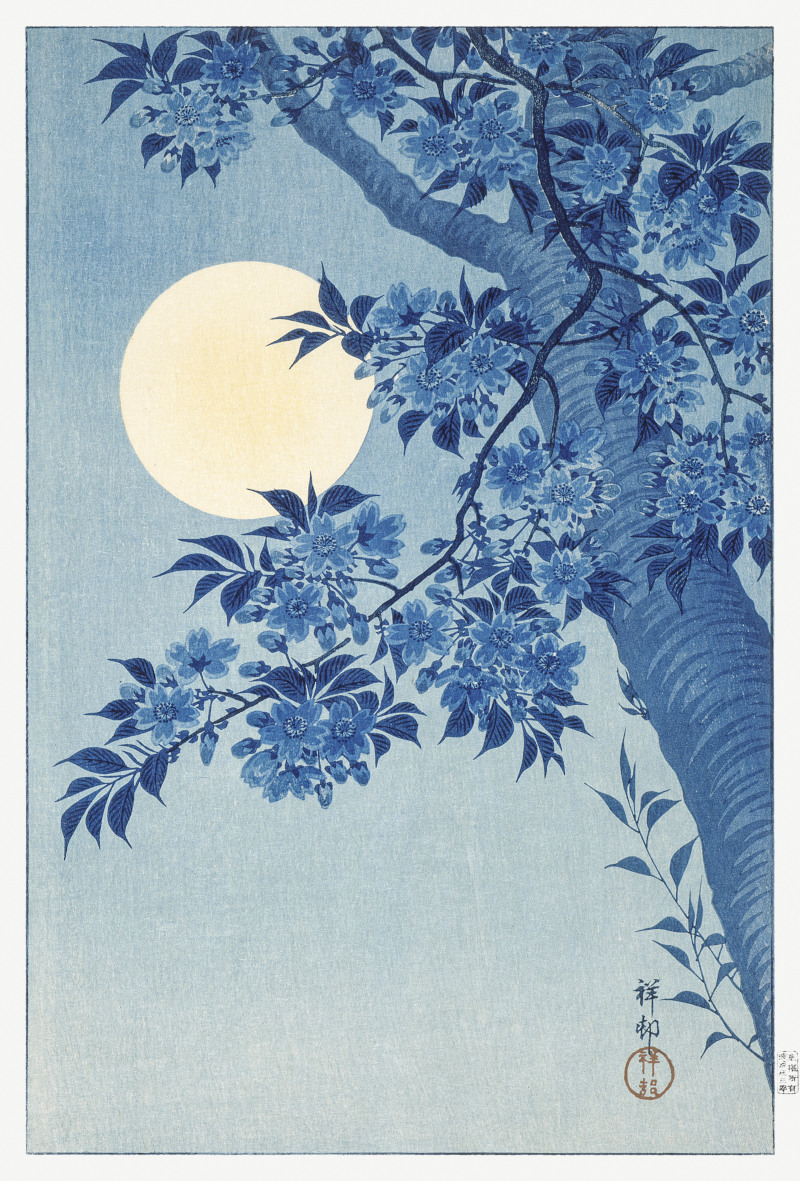 Blossoming Cherry on a Moonlit Night by Ohara Koson
Blossoming Cherry on a Moonlit Night by Ohara Koson
Chinese Landscape Vintage Painting by Lan Ying
Lan Ying is a famous landscape painter from China who worked with watercolors. The trees within this landscape artwork are charmingly delivered in an abstract format, with dabs of brown paint producing the foliage, and darker, thick lines for the trunk. Distance is producing by using lighter tones for the mountains in the background, whilst shadowing is created with horizontal grey tones which lie beneath the trees. There is also plenty of white, negative space which helps to produce a misty atmosphere.
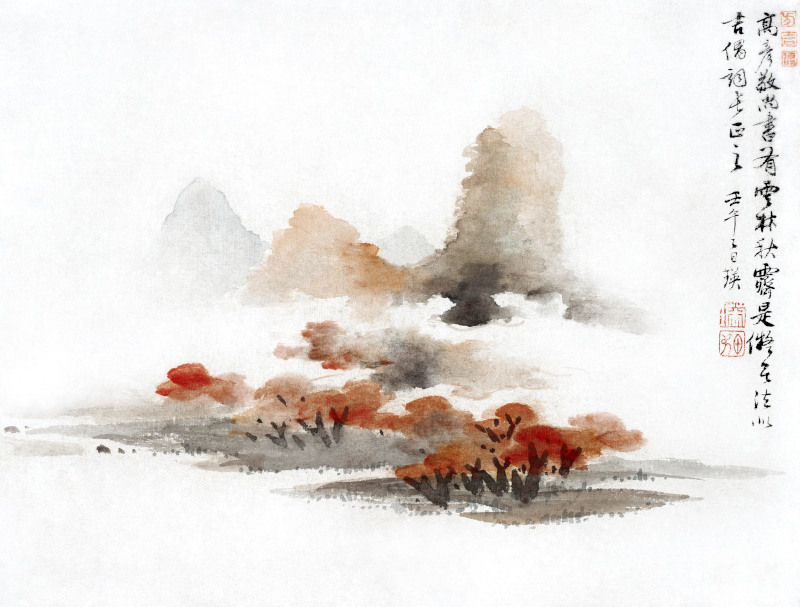 Chinese Landscape Vintage Painting by Lan Ying
Chinese Landscape Vintage Painting by Lan Ying
The Mulberry Tree by Vincent van Gogh
Van Gogh loved to use trees as the main subjects of his work, and in this example focuses on a mulberry tree. Wavy lines are used throughout to produce a dream-like feel, and black tones are used to provide clarity of form, as it contrasts against much lighter colors. Van Gogh also combines blues against yellows and light browns in order to differentiate the foreground and background, to give a more impactful finish.
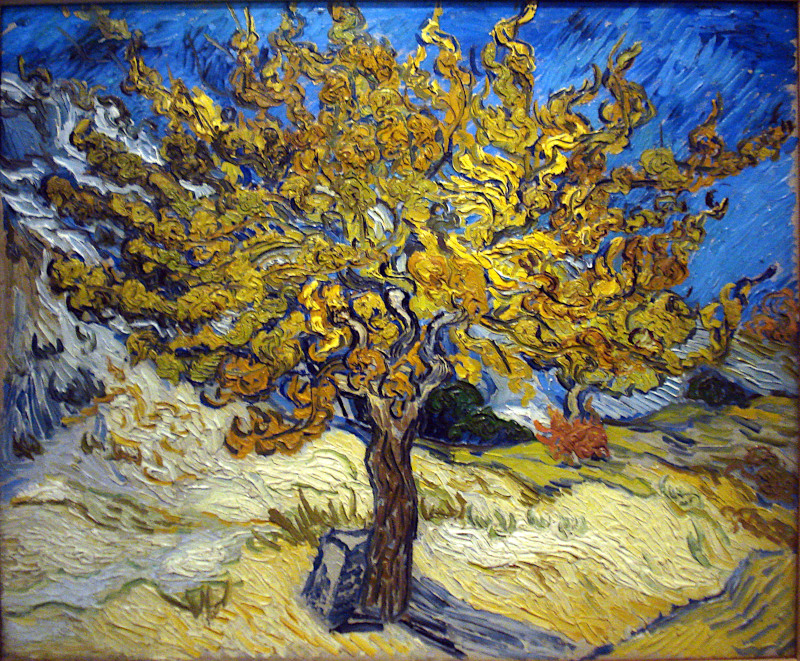 The Mulberry Tree by Vincent van Gogh
The Mulberry Tree by Vincent van Gogh
The Oak Tree in the Snow by Caspar David Friedrich
The darker side of nature is shown in this work by Friedrich. He regularly focused on trees within his Romanticist art, but often used them to symbolise decay and death. Here we find a wintery setting, with a tree devoid of all foliage. A trunk stands prominently, with its supporting branches jutting out horizontally, but looking tired and desperate. The tree itself is almost entirely black or dark browns, with no visible signs of life to be found within this downbeat artwork.
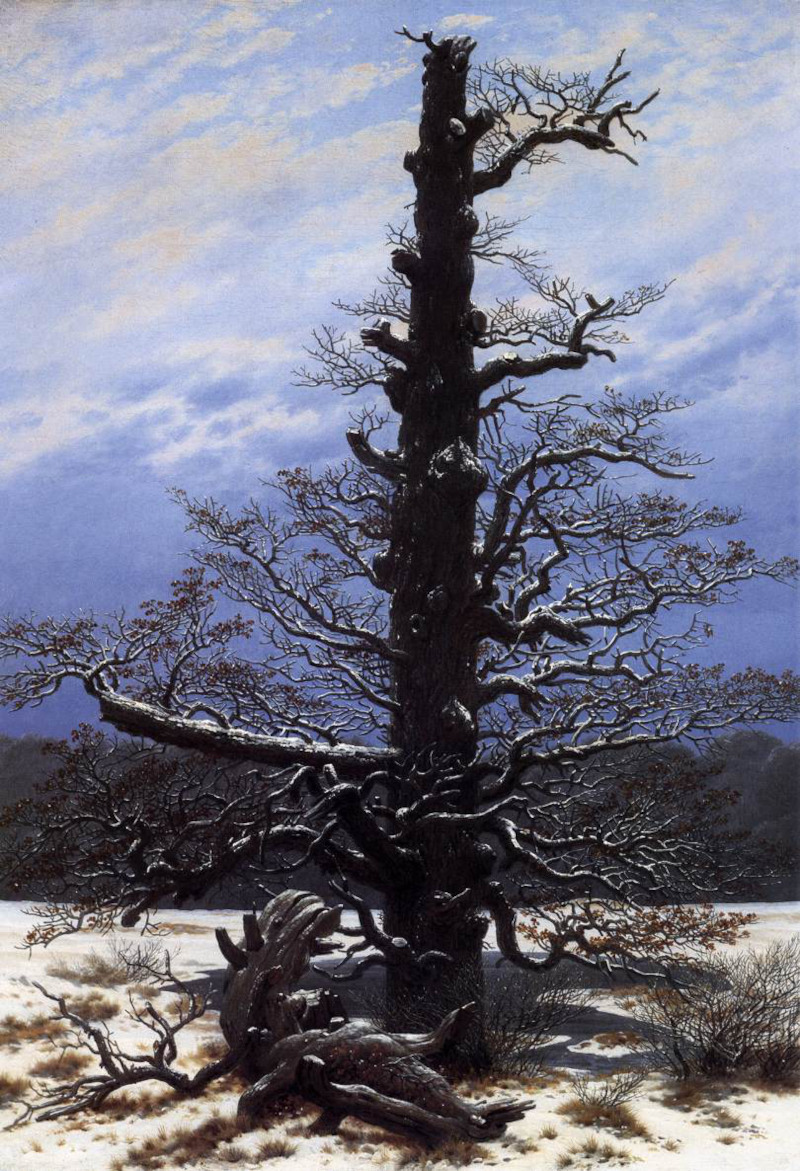 The Oak Tree in the Snow by Caspar David Friedrich
The Oak Tree in the Snow by Caspar David Friedrich
Vintage Japanese illustration by Hiroshige
Japanese art is shown here at its best, with a series of bright foliage delivered in white tones. They sit on top of thin, dark strokes of paint which deliver the narrow trunks. The sky is left clear, with mountains reaching up into the distance. Hills in the foreground roll either side of a tranquil river. Japanese artists captured trees as much as anyone and was respected for their contributions to landscape art.
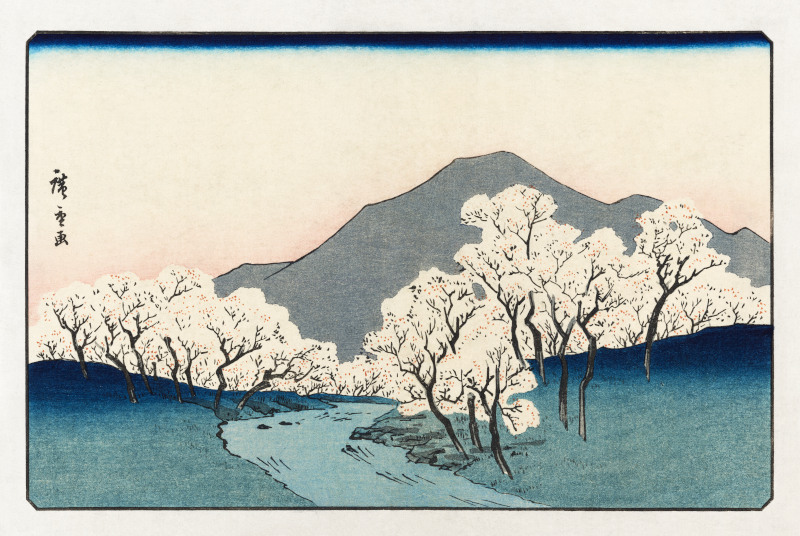 Vintage Japanese illustration by Hiroshige
Vintage Japanese illustration by Hiroshige
Pines Along the Shore, Pointilist, Fauvist by Henri-Edmond Cross
This work by Henri-Edmond Cross captures a shoreline, and uses the colors of a Fauvist work, with the small dabs of paint from Pontilism. It is a breaktaking piece and represents how European art changed after the early advancements of the Impressionists. Cross was not the most prominent of artists within any of these groups, but famous enough to remain widely documented today and may well have influenced others that followed in the 20th century.
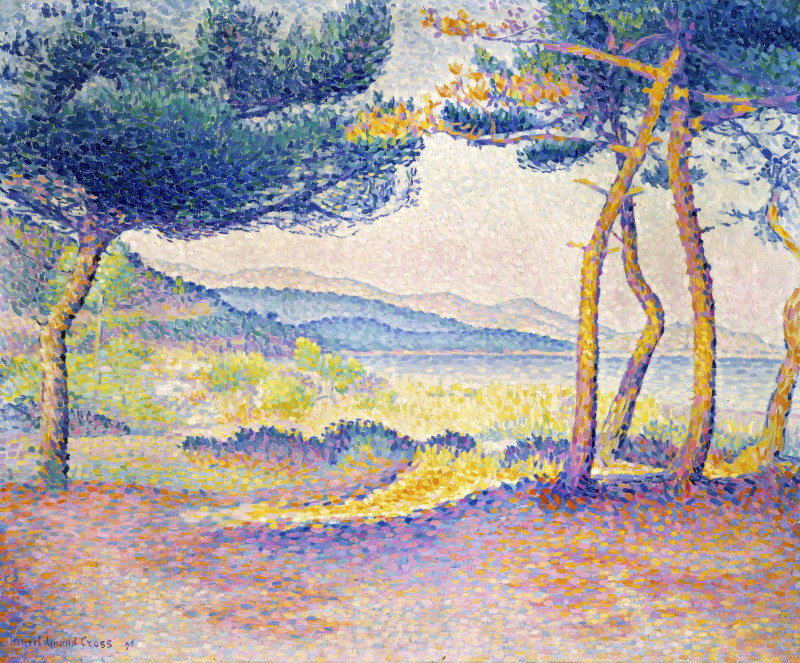 Pines Along the Shore, Pointilist, Fauvist by Henri-Edmond Cross
Pines Along the Shore, Pointilist, Fauvist by Henri-Edmond Cross
Japanese Autumn Tree
This delightful Japanese illustration captures a tall tree, with flowers added in tones of yellow and red on top of the initital black strokes of pen. This style of art can allow us to appreciate how the tree is formed, as we identify individual lines which together form the overall piece. This work could be completed relatively quickly, and potentially even completed on modern devices such as a tablet, as the artwork is built-up over time.
Detailed Tree Sketch from the 19th Century
By contrast to some of the other drawings in this article, there is a huge amount of detail added to this drawing. The master who produced it was from northern Europe in the early 19th century and had clearly followed some intensive training as a draughtsman in order to achieve such a high level of precision. Every last leag is added, with gaps appearing between branches to allow a contrast in shadow. Further trees are added in the distance to deliver a touch of perspective, both in their reduced size but also in their lighter tones.
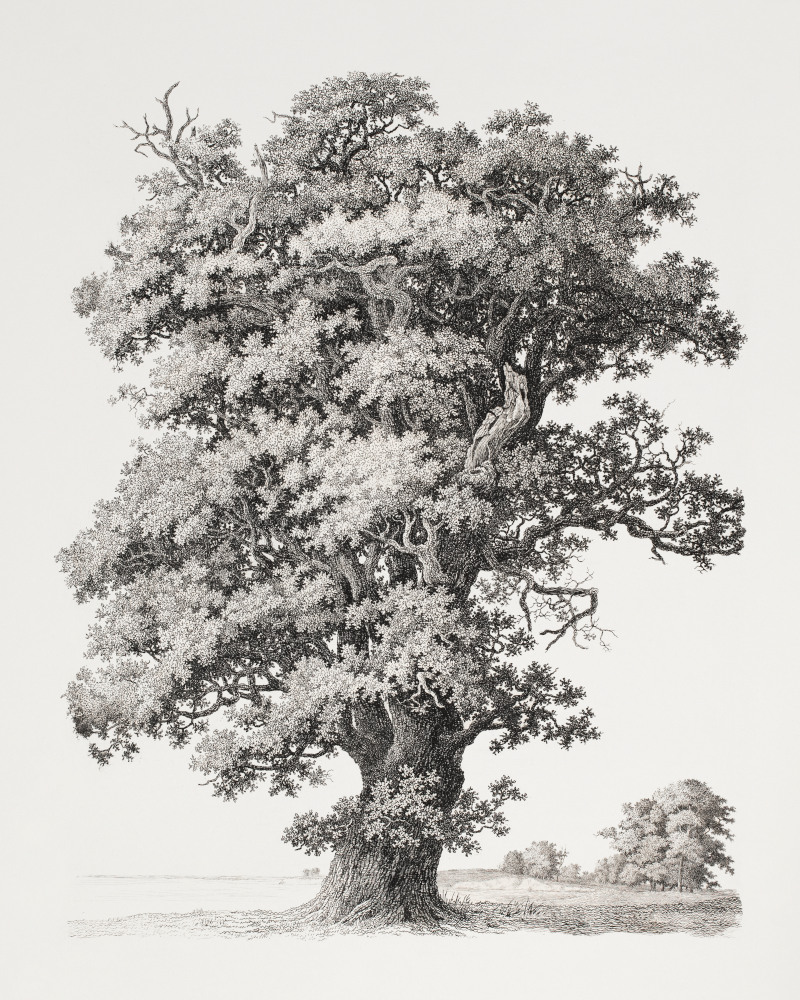 Detailed Tree Sketch from the 19th Century
Detailed Tree Sketch from the 19th Century
Introduction to Tree Drawing, Art, and Painting
Trees have been an inspiration to artists for centuries, and have been covered in a whole multitude of different styles. Drawing is the rawest technique in which to connect to these mighty plants, and their presence has been used for a number of different symbolic values. Their size alone can excite us all, and a number of religious groups have found an inherent spirituality to these great items. They have also inevitably been involved in the rise of landscape art, and also help us to give specific locations to different paintings, depending on the types of trees used.
As with many other artistic topics, such as fish and birds, initial interpretations were fairly abstract and primitive, before accuracy improved dramatically over the past five centuries. The 20th century then saw a return to abstraction and expression, as artists sought to move away from precise realism or the scientific method of capturing different species of plant. Today, all options are available to artists, along with many new methods brought about by the rise in digital art.
The Basics of Drawing Trees
The structure must be understood, in order to produce accurate depictions. Trees consist of a trunk, branches, and a canopy of leaves, and their relationship with each other will change depending on environmental conditions. Therefore, it is necessary to learn the different sections, before studying how they interact with each other. One can then start to work on drawing some of these great plants. The best method is to start by loosely sketching outlines, with tree textures coming much later.
Light strokes of the pencil can be used to create form, with darker, more aggressive strokes coming later once you are confident with the overall direction of the piece. Perspective and proportions are other areas in which a drawing might fall down, and so good planning initially can help to make sure that each part is correctly size in relation to the rest of the tree. Once the overall tree is delivered, one can then observe smaller details such as leaf shapes, branch thickness and so much more. You might find that different tools are more usef
Tree Art Styles and Techniques
We all understand the flexibility of trees within art, and many different movements have incorporated them, from abstract works of ancient times, to the minimalist approach of 20th century artists. In between, we saw some stunning works within the Impressionist and Expressionist movement, as well as Realism, in which the lives of rural workers came to the fore for the first time. Some Romanticists have even produced large-scale oil paintings in which the trees have been the focal point, such as with the work of Friedrich, whilst British artists have dotted them across the background in a number of landscape paintings, such as Turner, Constable and the related work of Gainsborough.
Collage has also risen in popularity recently, enabling artists to even incorporate elements of nature directly in the work itself, whilst digital art allows people to collaborate online and build up illustrations without having to meet in person. Technology will likely impact the future direction of art, bringing new opportunities, both in how art is produced, but also in how it is shared and promoted.
Artistic Attributes of a Variety of Trees
Many choices of tree by artists will be based around whatever is available in their region, but normally there will at least be a small variety to pick from. This then allows an artist to consider the attributes of each tree type, and pick accordingly. Oak trees can symbolise strength, through their thick trunks, and they can grow to a considerable age, potentially representing wisdom too. Willow trees, by contrast, are slim, elegant trees which can give more of a feeling of contemplation and reflection.
Cherry Blossom Trees were regularly found in Japanese art and created a gentle atmosphere, with their aesthetic value and bright color being highly suitable for art from this region. Blossoming, by its very nature, can represent new life. Similar to oak, redwoods can symbolise strength through their incredible heights, though they maybe found in different regions. Birth trees are tall but slim, allowing light to fill a scene, even in a dense forest. Of those other options, there is of course the palm tree too, which in some societies is seen as representing an exotic location, with it requiring heat to thrive.
The Techniques of Bark Rubbing
Tree rubbing, or bark rubbing, involves a simple process in which the surface of the bark is used to create an artwork. Paper or other light materials are laid over the surface, before being pressed down and a medium applied. The indentations create a variation of tone, and the final piece will resemble the surface of the tree trunk or branch when done correctly. Children can easily be introduced to artistic techniques by following these simple and fun processes, and often also become involved in brass rubbing too.
Artistic freedom can then be expressed as we try out different trees, combined with different mediums, such as charcoal, crayons, and even items other than trees, such as leaves, nuts, flowers and more. This method also has the advantage of getting people involved in nature, and can even be completed whilst outside in nature itself.
Composition and Perspective in Tree Art
Japanese art brought new methods to the table in terms of composition, and no-longer was it necessary to cover the entire tree with an artwork. Their artists would regularly just show a small selection, focusing on specific features such as just a few branches with blossoming flowers. Impressionists in Europe would then start to make use of these ideas too, once Japanese woodblock prints had been imported from the East after a period of isolation had ended. Perspectives can also be experimented with, with larger trees overshadowing elements below them. One can also handle them from different angles, in order to create different atmospheres, including that of strength or vulnerability.
Color and Light in Tree Painting
Color and light are important factors to consider in tree art, particularly when using oils, acrylics or watercolors. Light was key to the Impressionists, who studied how light would effect nature over the course of the day, and in different seasons. They learnt about how very different atmospheres and appearances would occur under different circumstances, just as with sunset painters, who loved the dramatic lighting found towards the start and end of the day.
Colors will also vary across trees, including those with blossoming flowers which have been used so often in Japanese art. Colors can completely change the balance of a work, bringing a positive feeling of life, or a dark mood of death, depending on the style used by the artist. Some would even depict the same tree in both lights, across different artworks to show visually how an object can be manipulated by the artist.
Famous Tree Artists and Their Works
A number of artists have given particular attention to trees within their work, with Piet Mondrian being one such example of that. He was slowly transitioning to an abstract style as he created the likes of Gray Tree, and they would become amongst his most highly regarded works. Vincent van Gogh would also tackle trees in inventive ways, and he clearly saw the beauty in these plants, sometimes choosing them as the main subject of his compositions. The French landscape very much inspired this Dutchman, particularly when it was saturated by light from the strong summer sun.
It was necessary for British landscape painters to master trees within their work, as they make up such a prominent part of most parts of the countryside. We would also find a number of tree artists in Japan, such as Hokusai and Hiroshige, who applied their beauty to a number of their memorable scenes. Beyond that, we would find more abstract interpretations right across the 20th century.
Tree Drawing and Art as a Therapeutic Practice
Sitting in the countryside, slowly sketching nature is a beautifully relaxing hobby, whether you are working professionally or purely for fun. Focusing on items of nature, as well as focusing the mind on the practice of sketching can help a meditative impact on your mind. Many will sit in their garden initially, perhaps sketching flowers close by before becoming bolder and setting off into the wilderness, armed with only a small sketchpad and a few pencils. Working like this can also help you to train the mind to observe and notice much more about nature than previously you would have noticed, helping to bring it to life.
Conclusion: Embracing the Beauty of Trees Through Art
In conclusion, it is clear that trees have been used in art for many thousands of years, and continue to inspire artists today, all across the world. There are certain techniques and principles which can eable you to put together simple drawings relatively easily, but the more precise works will require much more practice and observation. It is also true that different cultures have embraced these majestic plants in different ways, partly because of the geographical nature of the many species, meaning only a few would have been accessible to most artists until relatively recently.
Trees have brought great elements of symbolism into art across different religions, as well as spiritual movements. This can range from strength and wisdom to beauty and femininity, depending on the physical attributes of each tree type. We have all observed them in different states across our lifetime, and understand their process of growth.



